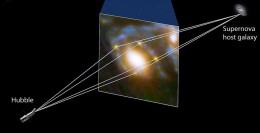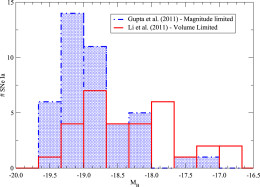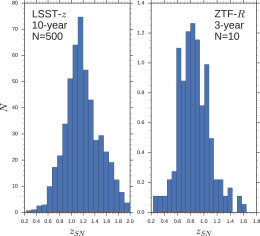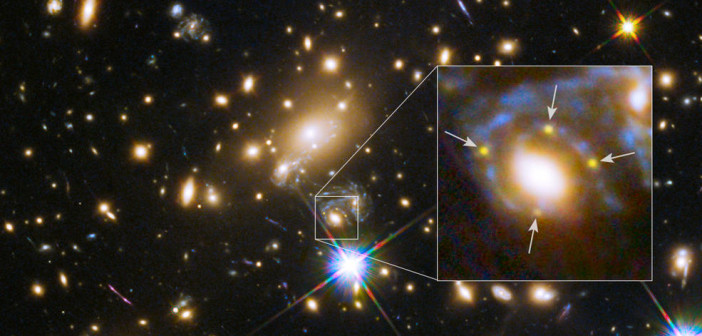Type Ia supernovae that have multiple images due to gravitational lensing can provide us with a wealth of information — both about the supernovae themselves and about our surrounding universe. But how can we find these rare explosions?
Clues from Multiple Images
When light from a distant object passes by a massive foreground galaxy, the galaxy’s strong gravitational pull can bend the light, distorting our view of the background object. In severe cases, this process can cause multiple images of the distant object to appear in the foreground lensing galaxy.

An illustration of gravitational lensing. Light from the distant supernova is bent as it passes through a giant elliptical galaxy in the foreground, causing multiple images of the supernova to appear to be hosted by the elliptical galaxy. [Adapted from image by NASA/ESA/A. Feild (STScI)]
The catch? So far, we’ve only found one multiply-imaged Type Ia supernova: iPTF16geu, discovered late last year. We’re going to need a lot more of them to develop a useful sample! So how do we identify the mutiply-imaged Type Ias among the many billions of fleeting events discovered in current and future surveys of transients?
Searching for Anomalies

Absolute magnitudes for Type Ia supernovae in elliptical galaxies. None are expected to be above -20 in the B band, so if we calculate a magnitude for a Type Ia supernova that’s larger than this, it’s probably not hosted by the galaxy we think it is! [Goldstein & Nugent 2017]
- From the data, select only the supernova candidates that appear to be hosted by quiescent elliptical galaxies.
- Use the host galaxies’ photometric redshifts to calculate absolute magnitudes for the supernovae in this sample.
- Select from this only the supernovae above the maximum absolute magnitude expected for Type Ia supernovae.
Supernovae selected in this way are likely tricking us: their apparent hosts are probably not their hosts at all! Instead, the supernova is likely behind the galaxy, and the galaxy is just lensing its light. Using this strategy therefore allows us to select supernova candidates that are most likely to be distant, gravitationally lensed Type Ia supernovae.

Redshift distribution of the multiply-imaged Type Ia supernovae the authors estimate will be detectable by ZTF and LSST in their respective 3- and 10-year survey durations. [Goldstein & Nugent 2017]
Future Prospects
How useful? Goldstein and Nugent use Monte Carlo simulations to estimate how many multiply-imaged Type Ia supernovae will be discoverable with future survey projects. They find that the Zwicky Transient Facility (ZTF), which will begin operating this year, should be able to find up to 10 using this technique in a 3-year search. The Large Synoptic Survey Telescope (LSST), which should start operating in 2022, will be able to find around 500 multiply-imaged Type Ia supernovae in a 10-year survey.
Citation
Daniel A. Goldstein and Peter E. Nugent 2017 ApJL 834 L5. doi:10.3847/2041-8213/834/1/L5


2 Comments
Pingback: looking for lensed SNs
Pingback: Featured Image: Using Supernova Refsdal to Measure the Hubble Constant